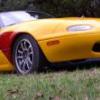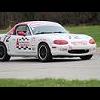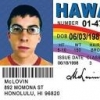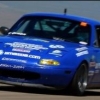Pad cracking/bending is almost always caused by the pad not being properly seated in the bracket. The bend will be about 2/3 from one end, With the bend point at the witness mark from the caliper piston. Almost always on the inboard pad. Here's what happens:
You install new pads properly in the mount. The rotor flops and knocks the pad out of position while you are installing the caliper. You can see the outer pad, so you reposition and start over. You don't see the inboard pad and the caliper goes back on. You naturally pump up the brakes, which bends the pad. You get a funky feel to the brakes. It feels fine in the pits, but is soft for the first part of travel, then gets hard like normal, but longer than normal. Car stops almost normally. the piston is getting pushed back into the caliper by the bent pad acting like a spring. The pedal is long and soft until you bend the pad enough to take up the gap, then it returns to normal. Eventually the flexing of the pad will crack the friction material and the friction material may fall off.
How to prevent: After installing the rotor on the hub, put 1 lugnut on, finger tight. This prevents the rotor from flopping around. Use the anti rattle clips, they help hold the pad in place. These do not work with Cobalt brand pads as they have wide mounting ears and do not fit with the anti rattle clips in place. Be aware of what can happen and double check your self.
If you have tapered pad wear, you have something binding or worn. Minimal taper is always expected, maybe 0.015-0.020". Unless you are using a caliper, you won't see or notice this. If you have severe taper, do not reposition the pads. the taper usually occurs in mirror image between the inner and outer pad. Flipping severelly tapered pads will create a "V" shape contact surface that gives you a long pedal as the tapered pad acts like a spring and pushes the piston back in.
Anytime you have a rear caliper pin come loose, replace the caliper bracket and the pin. When the pin comes loose it wobbles out the threads in the bracket. No amount of torque or locktite is enough to hold it permanently. AT least not to my satisfaction for brake parts. When any part of the brake system fails, it is usually a bad time. Any rebuilt part (calipers, Starters, water pumps, etc.) have been sand blasted at the factory, then they get painted. Any sand/debris in the threads is now sealed in place by the paint. EVERY rebuilt part with an exposed thread, should be cleaned with a proper tap or die to remove this debris prior to install. Next time you buy a rebuilt part, lay a clean piece of paper on the bench and run a tap through the mounting holes and look at how much debris falls onto the paper. You will be amazed.
As with most things, attention to detail will make life much better. Chase the threads and pay attention to the position of the inboard pad.
Road America is probably the worst track for breaking brake parts. We are there about 10 times a year. I have seen tooooo many times what happens when brakes fail. It is never pretty. Heed my warnings, please.
dave
Dave Wheeler
Advanced Autosports, the nations most complete Spec Miata shop
Author, Spec Miata Constructors Guide, version 1 and 2.0
Building Championship winning cars since 1995
4 time Central Division Spec Miata Champion car builder 2012-2013-2014-2017
Back to Back June Sprints Spec Miata 1-2 finishes 2016 and 2017
5 time June Sprints winner in Mazda's
6 Time Northern Conference Champion Car Builder
2014 SCCA Majors National point Champion car builder
2014 SCCA Runoffs winner, T4 (Bender)
2014 Central Division Champion, ITS (Wheeler)
2013 Thunderhill 25 hour winning crew chief
2007 June Sprints winner, (GT1, Mohrhauser)
Over 200 race wins and counting.
www.advanced-autosports.com
dave@advanced-autosports.com
608-313-1230




 Sign In
Sign In Create Account
Create Account






 Back to top
Back to top Report
Report






















